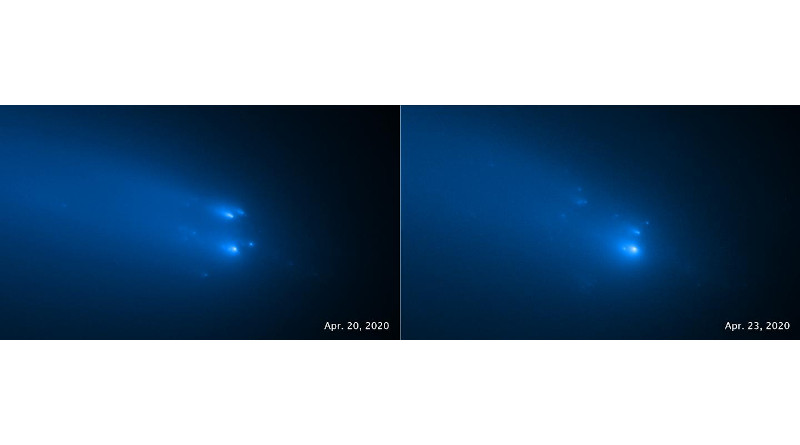Hubble Watches Comet ATLAS Disintegrate Into More Than 2 Dozen Pieces
These two Hubble Space Telescope images of comet C/2019 Y4 (ATLAS), taken on April 20 and 23, 2020, provide the sharpest views yet of the breakup of the fragile comet.
Hubble identified about 30 fragments on April 20, and 25 pieces on April 23. They are all enveloped in a sunlight-swept tail of cometary dust. “Their appearance changes substantially between the two days, so much so that it’s quite difficult to connect the dots,” said David Jewitt, professor of planetary science and astronomy at UCLA, Los Angeles, and leader of one of two teams that photographed the doomed comet with Hubble. “I don’t know whether this is because the individual pieces are flashing on and off as they reflect sunlight, acting like twinkling lights on a Christmas tree, or because different fragments appear on different days.”
“This is really exciting — both because such events are super cool to watch and because they do not happen very often. Most comets that fragment are too dim to see. Events at such scale only happen once or twice a decade,” said the leader of a second Hubble observing team, Quanzhi Ye, of the University of Maryland, College Park.
The results are evidence that comet fragmentation is actually fairly common, say researchers. It might even be the dominant mechanism by which the solid, icy nuclei of comets die. Because this happens quickly and unpredictably, astronomers remain largely uncertain about the cause of fragmentation. Hubble’s crisp images may yield new clues to the breakup. Hubble distinguishes pieces as small as the size of a house. Before the breakup, the entire nucleus may have been no more than the length of two football fields.
One idea is that the original nucleus spun itself into pieces because of the jet action of outgassing from sublimating ices. Because such venting is probably not evenly dispersed across the comet, it enhances the breakup. “Further analysis of the Hubble data might be able to show whether or not this mechanism is responsible,” said Jewitt. “Regardless, it’s quite special to get a look with Hubble at this dying comet.”
The comet was discovered on Dec. 29, 2019, by the ATLAS (Asteroid Terrestrial-impact Last Alert System) robotic astronomical survey system based in Hawaii. This NASA-supported survey project for Planetary Defense operates two autonomous telescopes that look for Earth-approaching comets and asteroids.
The comet brightened quickly until mid-March, and some astronomers anticipated that it might be visible to the naked eye in May to become one of the most spectacular comets seen in the last 20 years.
However, the comet abruptly started to get dimmer instead of brighter. Astronomers speculated that the icy core may be fragmenting, or even disintegrating. ATLAS’ fragmentation was confirmed by amateur astronomer Jose de Queiroz, who was able to photograph around three pieces of the comet on April 11.
The disintegrating comet was approximately 91 million miles (146 million kilometers) from Earth when the latest Hubble observations were taken. If any of it survives, the comet will make its closest approach to Earth on May 23 at a distance of about 72 million miles (116 million kilometers), and eight days later it will skirt past the Sun at 25 million miles (40 million kilometers).

